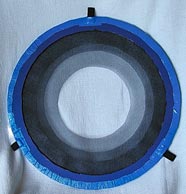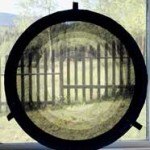
by Ken Florentino
Many people have seen me use a home-built apodizing mask while observing planets and have inquired about its use and design. An apodizing mask (I sometimes call it my “60’s filter”) is used to cut through the seeing much like an aperture stop. Technically, it is supposed to approximate a gaussian curve for the aperture instead of the sharp edge of the normal scope. In a refractor, it basically removes the first diffraction ring of the airy disk at the expense of fattening the central part of the disk somewhat. In an obstructed design like a Newtonian or SCT, there is some debate about it’s value.Also, the larger the secondary’s obstruction, the less it helps. It isn’t very useful in a scope smaller than 8 inches. For my scope (reflector) and my eyes, it seems to help on those less than perfect nights of seeing. Another “side effect” that it makes is a rainbow pattern around the object–hence “60’s filter” (psychedelic man)! The bottom line is that it helps see detail on planets and split double stars.

Here’s the quick and dirty on making one…
 Constructing the screen is very simple. I used three layers of standard fiberglass window screening material. All three screens are cut to the outside diameter of the telescope. Central holes are cut in the following diameters based on the size of the primary mirror: 1st screen: 90 percent, 2nd screen: 78 percent and 3rd screen: 55 percent. The size of the holes in a 10 inch telescope would then be: 9 in.; 7.8 in.; and 5.5 in.
Constructing the screen is very simple. I used three layers of standard fiberglass window screening material. All three screens are cut to the outside diameter of the telescope. Central holes are cut in the following diameters based on the size of the primary mirror: 1st screen: 90 percent, 2nd screen: 78 percent and 3rd screen: 55 percent. The size of the holes in a 10 inch telescope would then be: 9 in.; 7.8 in.; and 5.5 in.

The window screen sections are positioned so that their patterns are rotated by a successive offset of 30 degrees providing a relatively randomized blocking effect of the screen. All three screens are then sandwiched between two pieces of lightweight wood or cardboard and secured into place. The dimensions are not very critical, just adapt to your own scope. To use, simply place your mask into the front of your scope. My apodizing mask rests on top of the spider for my secondary.
Source: Improving Your Reflector Telescope Performance on Planets, Steve Waldee.
